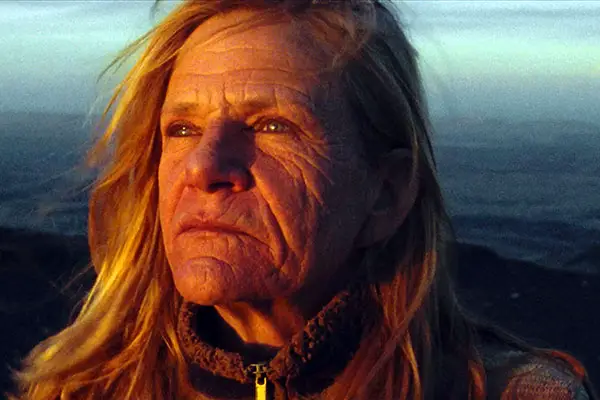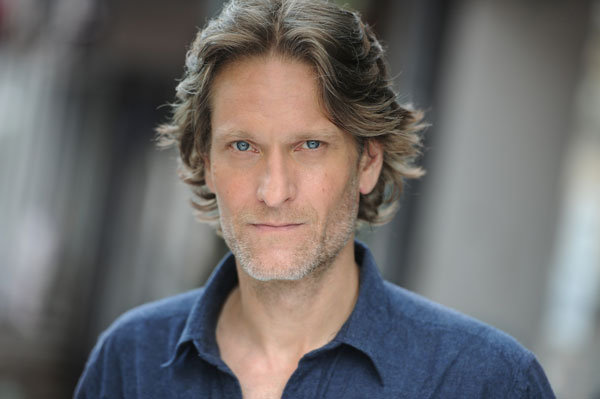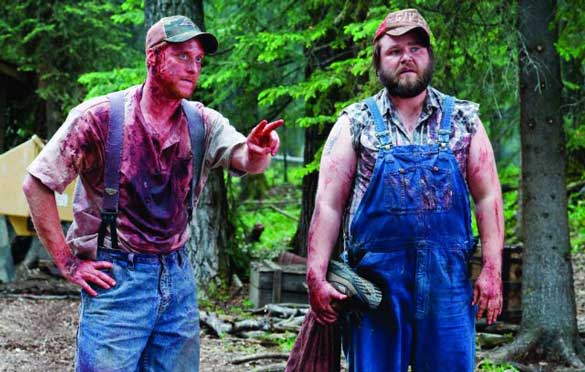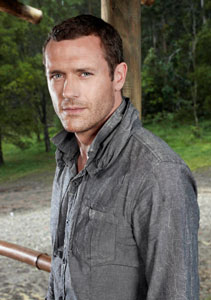 After some highly publicized delays, rewrites and re-shoots, Steven Spielberg‘s Terra Nova finally comes to the small screen this Monday in a big two-hour première on FOX.
After some highly publicized delays, rewrites and re-shoots, Steven Spielberg‘s Terra Nova finally comes to the small screen this Monday in a big two-hour première on FOX.
The show, starring Jason O’Mara and Stephen Lang, is set in the year 2149 at a time when humankind is threatened with extinction. In an effort to save the human race, scientists develop a time machine that opens a portal 85 million years to prehistoric Earth.
The Shannon family, Jim and Elizabeth and their three children, travel through the portal to establish a new human colony in hopes of saving the future earth.
Jason, whose credits include In Justice and Life on Mars, stars as Jim Shannon, “a devoted father with a checkered past who guides his family through this new world of limitless beauty, mystery and terror.” And dinosaurs. Yes!
I talked to Jason in a conference call about how he got the part, the acting challenges he had to face and the difficulties of shooting on location for months at a time.
Follow Jason on Twitter!
Terra Nova airs on Mondays at 8/7c on FOX
For the full interview, click the audio link above or download it from iTunes
How did this part and this show come to you?
Jason O’Mara: Well, to be perfectly honest it was one of those kind of things that was—okay, let me start at the beginning. I was in London doing a play at the Donmar Warehouse.
What play?
Jason O’Mara: It was called Serenading Louie. It was an off-Broadway play from like 1972, I think, or ’73, that was being revived and I did it with Jason Butler Harner, who is a great American actor. I think he’s going to be in Alcatraz on Fox in the mid-season. Simon Curtis directed it, who’s married to Elizabeth McGovern and he’s directed a lot of stuff recently, actually. He’s just directed My Week with Marilyn, which is coming out soon.
I really had a great time, but I really felt—I had skipped pilot season because I was in London for all of that and I thought that Hollywood had completely moved on and had lost interest in me, which would have been fine, you know, whatever. Things go in cycles. I came back and my agent called me and said, “Just so you know I’ve had several conversations with Dreamworks and Fox about a production that they’re working on called Terra Nova and Steven Spielberg is highly involved in the casting and is signing off on everything related to the production. That’s a hoop that we need to jump through before we progress any further.” I hadn’t got an offer or anything. This was just, you know they were just sort of checking my availability and seeing if I was interested. I read a version of the script, which has changed a lot since, but I was intrigued by the scale of it and the ambitiousness of it. After I was done reading it I thought that this can never be made for television; it’s too big. This is a movie. Then remembering that Steven Spielberg was involved, I thought well, if anybody can do it, he can.
What intrigued me most about the script was that it was really about second chances and if we were given a second chance as a race would we make the same mistakes? That was kind of the thing that hooked me onto it. I said to my agent, “You know I would be interested if it goes further.” He said, “Okay, well there are a lot of people involved with this because it’s such a big production. I’ll discuss this with everybody and get back to you.”
Then I got a phone call. I was walking down the street in New York City and I got a phone call from him again, my agent, saying, “Okay, Steven Spielberg has been in touch and he wants to watch some scenes from your work. He wants to see some reels.” But not my show reels, he wanted to see some more dramatic stuff. I sent some scenes from Life on Mars to my agent and he put them together on a web site for Mr. Spielberg to watch and he watched them.
Then I didn’t hear anything for about 48 hours and I was sure that I would not get this; that I wouldn’t hear any more about it and I got a phone call saying, “They want you to take the role of Jim Shannon on Terra Nova. Would you be interested?” I said, “Hey, man it has Steven Spielberg; it has dinosaurs and it’s one of the most ambitious TV projects of all time. That sounds like a dream, sign me up.” I did and I haven’t regretted a single thing. It’s been a wonderful journey.
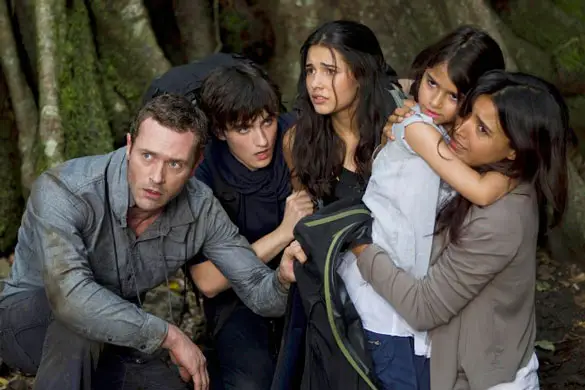
You’ve been on some good series that unfortunately haven’t quite caught on with audiences. Is there something different about this? Does it feel like this is really going to be the one that really sort of hits it out of the park in that regard for you?
Jason O’Mara: Oh, I hope so. Yes, third time lucky, is it, maybe? I’ve never got a show to a second season so I’m sure people online are painfully aware of this and maybe audiences are as well. What’s great about this is that in Life on Mars I had the most amazing cast assembled on television at the time, I believe, so I was ably supported in that.
In Justice was a great show, but I don’t think we were able to make enough noise to kind of break through, but with this I’m really not sweating the premiere because it’s really about whether people are ready for a show like this, and I believe they are.
It’s not really down to me. The show is way bigger than the actors are. Steven Spielberg’s presence is one of the selling points. The dinosaurs obviously are a huge aspect of all of this, so we’re hoping that people kind of come for these reasons, but stay because they’re enjoying the world we’ve created and the dynamics between the characters and the relationships that are forming. As the season progresses and deepens you’ll get to know the characters better and see where we’re going with the story lines.
To answer your question, I really feel like it’s out of my hands and I’ve done my work and now it’s just a question as to how much of a hit this is going to be. I think we might be on to something here, but I’ve been wrong in the past.
Could talk about sort of just acting in the world of Terra Nova—acting without dinosaurs actually being there and working such a physical show in the wilderness, so to speak.
Jason O’Mara: Yes, well, first of all you know Brisbane stood in for Chicago. Brisbane is the Australian city on the East Coast of Australia, and a lot of Chicago was CGI because we’re not dealing with Chicago, we’re dealing with that city 150 years or so from now.
We tried to recreate it in the most imaginative way possible. I think it looks pretty darn cool, but scary as well. The future is kind of a bleak place. Listen, it has been very challenging shooting this show. We’re outside for a lot of this. The Australian Outback can be quite unforgiving. We haven’t had any medical emergencies on the cast so far in terms of the wildlife. There are a lot of snakes. I don’t know how poisonous it was, but I had a toad like crawl across my boots just last week, which was really kind of cool actually, but we’re really out there. We’re really out there in the rain forest and on location and we’re exposed to the elements for better or for worse.
I mean anybody who goes out for a hike on a regular basis knows how tired you are in the evenings and you come back after a long day’s shooting of being out in the forest and you want the next day off, but we don’t get days off. The next it’s up early and it starts again. That’s the challenging thing with TV; it’s not the action scenes per se and it’s not the location scenes and the heavy dialogue scenes, but the fact that there is just no let up; there is no break. Oftentimes we’ll even work Saturdays to get all this in.
We’re shooting in eight or nine days per episode, but we shoot in blocks and to accommodate publicity like the tour I’m on now and other things we have to move the scheduling and the shooting days around, but it’s something we have made work for ourselves. It’s working so far. We shoot with three cameras per unit. Sometimes we shoot with two different units or where we’re shooting two different episodes at the same time. Sometimes we splinter units that have cameras on board helicopters. It’s a pretty big production—the size of which I’m not sure has been seen in recent memory on broadcast TV.
Could you tell us what maybe sticks out most in your mind about shooting the pilot for Terra Nova?
Jason O’Mara: Let’s see. Well, first of all, it’s been well documented how difficult some of the shooting days were on the pilot due to the inclement weather. As if it wasn’t hard enough trying to create as ambitious and as complicated a show as this is to make, we had to contend with some extreme weather. The days where I opened my trailer and stepped down and literally was up to my knees in a pile of mud—they were the days where you go, I don’t think we’re shooting today.
They were able to work magic with the schedule and oftentimes we would be back in a studio or whatever, wherever we needed to be while it rained cats and dogs outside, or cats and dinos, as it felt sometimes. So that was probably the most challenging aspect of that.
From an acting standpoint, what maybe were some of the initial acting challenges stepping into the role for you?
Jason O’Mara: Yes, well, I’ve always tried to keep my character—I like to play very raw characters, characters who have a degree of vulnerability and passion about what they’re doing. I suppose the greatest acting challenge was to allow Jim to have enough darkness and even allow him to be more flawed than perhaps he was on paper. That is something that I’ve sort of confidently been talking to the writers about, about trying to keep Jim as complicated as possible so he’s not just a hero running around protecting his family and chasing dinosaurs, either chasing after them or running from them, so that there is a little more to him than that.
I suppose that was sort of my challenge to try to keep Jim as grounded, as real, and as complicated and human as possible. Technically the green screen acting can be difficult because—there is something worse by the way than a tennis ball on the end of a stick, it’s an Australian visual effects assistant running around with a cardboard dinosaur head cut off on the end of a stick while wearing shorts and sandals running around a field. And you’re supposed to look intimidated and scared to death of this guy and he’s a very sweet guy, but it’s just really hard to be really scared of something like that when all you want to do is burst out into fits of laughter.
That stuff can be tricky and difficult, but then you’re really at the whim of the visual effects guys and the editor when it comes to that stuff, so you do your best with it and move on. I think just trying to keep Jim as edgy and engaging and as intriguing as possible given that we’re also trying to make this as appealing for as many different people as possible. That’s always a very thin line to walk.
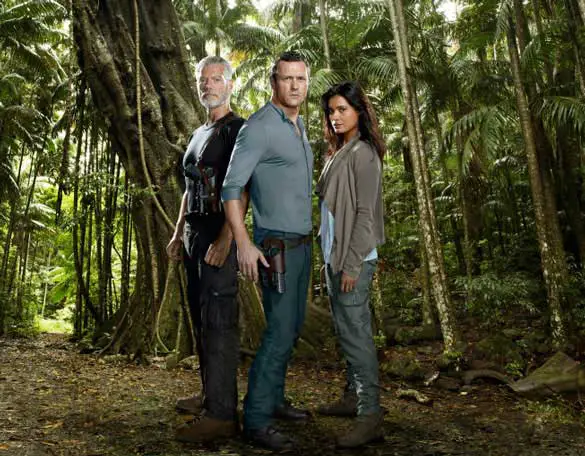
How was it decided to shoot there or using Brisbane as Chicago, for example?
Jason O’Mara: I’m not really involved in those decisions, but I know that there was talk initially—I only know just through the phone calls I would get last year and it has been well over a year now since this whole journey started for me. I would get a phone call saying, “Okay, right now they’re considering Louisiana.” “Right now they’re considering Hawaii.” “Right now they’re considering Florida again.” I think it was deemed that Australia would offer the show the right kind of locations in a pretty localized way. We’re only sort of 30 minutes drive from one place to another.
From where we live to the studio to the Terra Nova location to all of the other locations that we’ve been shooting like waterfalls and forests and beaches and cliff faces and all that stuff—it’s all pretty localized. There is an amazing amount of sort of topical diversity when it comes to landscape in a sort of small amount of space. I think that’s probably why it was chosen over the other places.
There is also a fairly established infrastructure there that is their sort of Hollywood. They have stages set up there and next to it is like a theme park called Movie World. Sometimes we have roller coasters and people screaming as we’re having a break inside the studio and walking from our trailers. It’s kind of funny. They do have that sort of already set up. They have very experienced crews. Our crews have been fantastic. It’s also a beautiful part of the world.
I think while I find the separation very difficult, and while I always prefer production to be done on U.S. soil because I think it’s important for jobs here in the states and to keep the industry in the states, I do understand why Australia was the set location for the first season of Terra Nova.
You mentioned Spielberg and time travel and dinosaurs and the intense shooting schedule and everything. Do you find it even the little off time that you’ve had a weird transition to doing mundane things like taking out the trash or doing dishes?
Jason O’Mara: No. No, what’s good about this is the really hard thing about this – the hardest aspect of all of this is being away from my family. I don’t know if I’ve answered any question like that since we started this call, but the hardest thing has been being away from my family. My wife, Paige Turco, who is an actress, who is pursuing a career from New York City and my son who is seven years old. I really, really miss them.
They have come over to visit me for an extended period of time, but not for the full five and a half months or whatever it’s been. I‘ve spent a lot of that time missing them terribly. That’s the bad news. The good news is my wife hasn’t been there to tell me to take out the trash, so every cloud has its silver lining. No, I did actually go to the—I’m so intense on this show; I work almost every scene. I work almost every day. I literally do not have time to take out the trash. I’m going to be coming down to earth hard when I get back home because that is one of my major jobs in the house is to stamp out the garbage.

